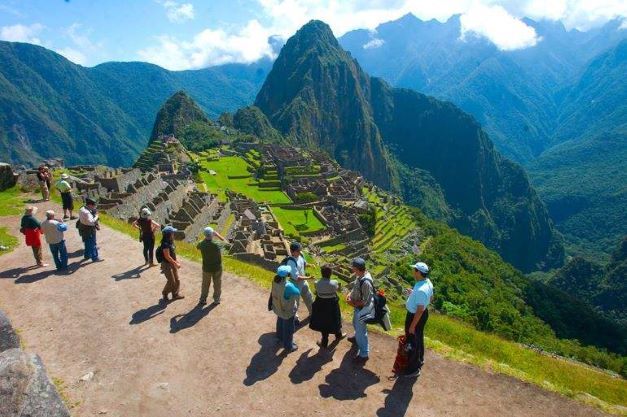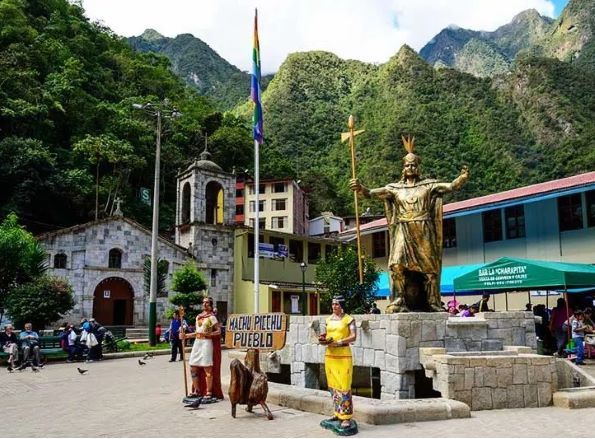The Spanish were one of the first to speak of the Lost City of the Incas where, apparently, the rebellious Incas were hiding, those who refused to submit. When the Spanish arrived in Peru, there were many fights between the Spanish and the Incas, which led many of the latter to take refuge. These thoughts were chronicled, but the site had no name yet.
In the territory of Peru we find one of the most enigmatic destinations on the planet: The ruins of Machu Picchu. This magical place has captivated its visitors for centuries, and scientists are fascinated by its mysteries. Its charm and mysticism are so marked that it has recently been chosen as one of the New Seven Wonders of the World.
Where is the Lost City of the Incas?

MACHUPICCHU 
machupicchu pueblo cusco peru
But, where is the Lost City of the Incas? Machu Picchu is located in southern Peru, on the eastern slope of the Andes. The majestic city towers over the Urabamba Valley. Archaeologists conjecture that Machu Picchu could have been one of the residences of Pachacútec, the first Inca emperor, who led his people around 1450.
Likewise, the various constructions with ceremonial purposes included in the site suggest that it also functioned as religious sanctuary.
It is estimated that 1,200 people lived in the city, occupationally and geographically distributed in three main areas: agricultural, urban, and religious. The lower areas of the site contain buildings occupied by farmers; in the middle areas of the mountain, the terraces and the irrigation systems take advantage of the natural slopes; and the most important religious areas are located at the top of the mountain, where the Sun King appears.
The re-discovery of the Lost City of the Incas by Hiram Bingham
In 1911 it was Hiram Bingham who made the scientific discovery of the Lost City of the Incas, supported by an expedition from Yale University in the USA and the National Geographical Society. It can be said that the find was a coincidence, since Hiram Bingham was looking for the city of Vilcabamba, which was the last refuge of the Incas and the last point of resistance against the Spanish.
The ruins of Machu Picchu, known as the “Lost City of the Incas,” were rediscovered in 1911 by archaeologist Hiram Bingham of Yale. Legends and myths indicate that Machu Picchu (a Quechua term that means old mountain or higher peak) was venerated as a sacred place.
In addition, it is known that Machu Picchu was an astronomical observatory. The Intihuatana stone (hooking rod of the sun) is an accurate indicator of the date of the two equinoxes and other significant celestial periods. At noon on March 21 and September 21, the sun falls directly on the pillar, it does not create any shadow.
With more than 150 houses and buildings in a great state of conservation, Machu Picchu is considered at the same time a masterpiece of architecture and engineering. These structures, carved from the gray granite of the mountain top, are marvels of architectural and aesthetic genius. Many of the building blocks weigh 50 tons or more, and were sculpted to millimeter perfection.
When Hiram Bingham rediscovered Machu Picchu, he named it “Lost City of the Incas“,because he thought it was in the city of Vilcabamba, the last place of refuge for the Incas after the Spanish conquest. As a product of the Yale professor’s research, 40,000 objects including ceramics and silver statues were extracted, which were taken to the United States university.
However, in addition to the locals, it is known that the farmer Agustín Lizárraga arrived nine years before Bingham. The Cusco writer Américo Rivas was the one who wrote a book in which he recounted all the details of such an important find. Even the copy entitled Agustín Lizárraga: The great discoverer of Machu Picchu, points out that the land tenant left his name written in the sanctuary as proof that he was visiting.
Since Hiram Bingham discovered Machupicchu in 1911, the place has captured the admiration of the entire world and is perhaps the most identifiable historical place for Peru.
The Mystery of the Lost City of the Incas
Even today the certainties about Machu Picchu are scarce. It is known that the Incas built it around 1450 and that they abandoned it a hundred years later, after the Spanish conquest. Its geographical isolation, between jungle and mountains, made it go unnoticed until 1911,
when the American historian Hiram Bingham reached the ruins thanks to local shepherds and disclosed its remains to the rest of the world. Some researchers believe that it was the resting place of the Inca royalty, others think that it housed a ceremonial center or a military fortress.
For these reasons and many more, Machu Picchu is one of the tourist destinations that everyone should visit. Either for the love of history, or for the love of the exotic, every travel lover should know this incredible place.
The Legends of Machu Picchu
Machupicchu is one of the archaeological remains that arouses particular interest throughout the world and is, without a doubt, the best expression that demonstrates the capacity of the Andean man. Many theories about Machupicchu are raised, of which, already outlined, we specify the following:
- The first theory indicates that this city was unknown to the Incas, this is due to the type of construction and the lack of historical data that would indicate that it was a construction older than that of the Incas, that is, it belonged to the pre- inca.
- The second theory indicates that it was a Vestal center, for the refuge of the Ñustas or Virgins of the Sun, for which we can consider that it was a Sacred City: this theory occurs because, upon the arrival of the Spanish, the Inca rulers, with In order to avoid more robberies, they made these chosen women escape to a secret place in the Andes, this place turning out to be the city of Machupicchu. This theory is also explained by the discovery of 107 human remains, of which 68.9% were the remains of women.
- A third theory proposes that Machupicchu was the last Capital of the Empire and that Vilcabamba was the the Lost City of the Incas where the Incas retired under the command of Manco Inca in the year 1536 when he was defeated by the Spanish after besieging Cuzco.
Tours to Machu Picchu
Inca Trail to Machupicchu
Machu Picchu represented the administrative capital. The roads that joined the four regions or theirs, began in the main square, and the land of each region was mixed in a ritual way with the land of Qosco.
His four were: Chichaisuyo, made up of northern Peru and Ecuador; Collasuyo that encompassed Lake Titicaca, Bolivia, Chile and part of Argentina; Antisuyo, formed by the eastern Amazon, and Contisuyo, western region of Cuzco.
The great agricultural production allowed the members of the empire to orient the work towards various works, such as the creation of roads that are preserved until today, of which the Inca Trail stands out and the construction of complex buildings with large stone blocks. The ruins of Machu Picchu, allow us to become aware of the power of this empire.
The Inca Trail discovered by Hiram Bingham in 1915 (4 years after the discovery of Machu Picchu) is, without a doubt, the most popular of the circuits that exist in South America.
This trail with more than 400 years of history has different accesses: the one at Km 82 (5 km from Chillca), in Qorihayrachina, or the Short Inca Trail that starts at Km 104 in Calchabamba. Several historians agree that the Inca Trail was the only access to the sacred city of Machu Picchu, in times of the Tahuantisuyo empire.
About 40 kilometers to the citadel of Machu Picchu. Walking between some lagoons and with the snow-capped mountains as scenery, we will enter the beautiful ruins of Sayacmarca (3,580 meters above sea level). Then, we arrived at the City of the Clouds, Puyupatamarca (3,640 masl), after having seen for the first time from the heights, the town of Aguas Calientes. To finally descend to the ruins of Wiñaywaina, at 2,650 meters above sea level, the gateway to Machu Picchu.










